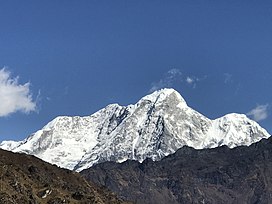레오니스로39번길
39 Leonis| 관측 데이터 에폭 J2000 이쿼녹스 J2000 | |
|---|---|
| 별자리 | 레오 |
| 우측 상승 | 10h 17m 14.538s[1] |
| 탈위임 | +23° 06′ 22.38″[1] |
| 겉보기 크기(V) | 5.81[2]/11.40[3] |
| 특성. | |
| 스펙트럼형 | F6 V[4] + M1[3] |
| U-B색지수 | –0.05[5] |
| B-V색지수 | +0.50[5] |
| 아스트로메트리 | |
| 방사 속도(Rv) | +37.4km[6]/s |
| 적정운동(μ) | RA:−413.372mas/yr[1] Dec.:−98.047mas/yr[1] |
| 시차(시차) | 44.9008 ± 0.0699 마스[1] |
| 거리 | 72.6 ± 0.1 ly (22.27 ± 0.03 pc) |
| 세부 사항 | |
| 사자자리 39 | |
| 미사 | 0.98[7] M☉ |
| 반지름 | 0.99[8] R☉ |
| 루미도 | 2.19[7] L☉ |
| 표면 중력(log g) | 4.29±0.14[2] cgs |
| 온도 | 6,118±49[2] K |
| 금속성 [Fe/H] | –0.27[2] 덱스 |
| 회전 속도(v sin i) | 2.16km[9]/s |
| 나이 | 6.3[2] Gyr |
| 사자자리 39 B | |
| 반지름 | 0.48[8] R☉ |
| 표면 중력(log g) | 4.83±0.05[3] cgs |
| 온도 | 3,740±40K[3] |
| 금속성 [Fe/H] | -0.33±0.06[3] 덱스 |
| 기타 지정 | |
| 데이터베이스 참조 | |
| 심바드 | 자료 |
39 레오니스(Leonis)는 레오 12궁도의 별자리에 있는 별을 나타내는 플램스티드(Plamsteed)의 명칭이다.겉보기에는 5.90의 시각적 크기를 가지고 있어서, 보틀 스케일에 따르면, 밤에 교외 하늘에서 희미하게 보인다.시차 측정은 연간 시차 변화량이 0.0449㎝[1]로 태양으로부터 약 72.6리(22.3pc) 거리에 해당한다.
39 레오니스의 별 분류는 F6 V로 주계열성임을 나타낸다.[4]질량과 크기는 거의 같지만 태양보다 두 배 이상 높은 광도로 빛난다.[7][8]이것은 63억 살로 추정되는 성숙한 별이다.수소와 헬륨 이외의 원소의 풍부함은 태양에 있는 원소의 약 절반으로, 이 원소는 금속이 부족한 별이 된다.[7]항성 대기의 유효 온도는 6,118 K로 [2]F형 별의 황백색 후두 빛을 낸다.[11]
파장 18μm의 아카리 위성으로 관측한 결과 적외선 방출이 초과된 것으로 나타났다.이는 4 천문단위(AU) 이상의 거리에서 항성을 공전하는 내부 파편 원반이 존재함을 시사한다.22 μm에서는 유의미한 초과가 발견되지 않았다.[7]
동반성은 302.7의 위치 각도를 따라 7.72㎝의 각 분리 지점에 위치한다.°—이것은 175AU의 예상 분리에 해당한다.[12]그것은 M1의 분류와 겉보기 시각적 크기가 11.40인 적색 왜성이다.[3]
참조
- ^ a b c d e 이 소스에 대한 Brown, A. G. A.; et al. (Gaia collaboration) (2021). "Gaia Early Data Release 3: Summary of the contents and survey properties". Astronomy & Astrophysics. 649: A1. arXiv:2012.01533. Bibcode:2021A&A...649A...1G. doi:10.1051/0004-6361/202039657. S2CID 227254300.Gaia EDR3 레코드 VizieR.
- ^ a b c d e f Maldonado, J.; et al. (May 2012). "Metallicity of solar-type stars with debris discs and planets". Astronomy & Astrophysics. 541: A40. arXiv:1202.5884. Bibcode:2012A&A...541A..40M. doi:10.1051/0004-6361/201218800. S2CID 46328823.
- ^ a b c d e f Woolf, Vincent M.; Wallerstein, George (February 2006), "Calibrating M Dwarf Metallicities Using Molecular Indices", The Publications of the Astronomical Society of the Pacific, 118 (840): 218–226, arXiv:astro-ph/0510148, Bibcode:2006PASP..118..218W, doi:10.1086/498459, S2CID 119340035.
- ^ a b Phillips, N. M.; et al. (April 2010), "Target selection for the SUNS and DEBRIS surveys for debris discs in the solar neighbourhood", Monthly Notices of the Royal Astronomical Society, 403 (3): 1089–1101, arXiv:0911.3426, Bibcode:2010MNRAS.403.1089P, doi:10.1111/j.1365-2966.2009.15641.x, S2CID 119262858.
- ^ a b Johnson, H. L.; et al. (1966), "UBVRIJKL photometry of the bright stars", Communications of the Lunar and Planetary Laboratory, 4 (99), Bibcode:1966CoLPL...4...99J.
- ^ Nordström, B.; et al. (May 2004), "The Geneva-Copenhagen survey of the Solar neighbourhood. Ages, metallicities, and kinematic properties of ˜14,000 F and G dwarfs", Astronomy and Astrophysics, 418: 989–1019, arXiv:astro-ph/0405198, Bibcode:2004A&A...418..989N, doi:10.1051/0004-6361:20035959, S2CID 11027621.
- ^ a b c d e Fujiwara, H.; et al. (February 2013), "AKARI/IRC 18 μm survey of warm debris disks", Astronomy and Astrophysics, 550: A15, arXiv:1211.6365, Bibcode:2013A&A...550A..45F, doi:10.1051/0004-6361/201219841, S2CID 1844309.
- ^ a b c Pasinetti-Fracassini, L. E.; et al. (February 2001), "Catalogue of Stellar Diameters (CADARS)", Astronomy and Astrophysics, 367: 521–524, arXiv:astro-ph/0012289, Bibcode:2001A&A...367..521P, doi:10.1051/0004-6361:20000451, S2CID 425754.
- ^ Martínez-Arnáiz, R.; et al. (September 2010), "Chromospheric activity and rotation of FGK stars in the solar vicinity. An estimation of the radial velocity jitter" (PDF), Astronomy and Astrophysics, 520: A79, arXiv:1002.4391, Bibcode:2010A&A...520A..79M, doi:10.1051/0004-6361/200913725, S2CID 43455849.
- ^ "LTT 12754 -- High proper-motion Star", SIMBAD Astronomical Database, Centre de Données astronomiques de Strasbourg, retrieved 2013-10-13.
- ^ "The Colour of Stars", Australia Telescope, Outreach and Education, Commonwealth Scientific and Industrial Research Organisation, December 21, 2004, archived from the original on March 10, 2012, retrieved 2012-01-16.
- ^ Zapatero-Osorio, María Rosa; Martín, Eduardo L. (May 2004), "A CCD imaging search for wide metal-poor binaries", Astronomy and Astrophysics, 419: 167–180, arXiv:astro-ph/0402310, Bibcode:2004A&A...419..167Z, doi:10.1051/0004-6361:20035907, S2CID 1688885.


